| dc.description.abstract | The aim of this study was to investigate the difference in climbing-specific strength and rate of force development (RFD) between intermediate, advanced, and elite male sport climbers. Seventy-eight male climbers were recruited and divided into groups based on the International Rock Climbing Research Association (IRCRA) numerical (1–32) grading system (intermediate (10–17) group (IG; n = 28)), advanced (18–23) group (AG; n = 30) and elite (24–27) group (EG; n = 20). Peak force (Fpeak) and average force (Favg) were measured while performing an isometric pull-up on a 23 mm thick campus rung. RFD was calculated from the onset of force to maximal peak force. The elite group performed better in all test parameters than the advanced (Fpeak: 39.7%, ES = 1.40, p < 0.001; Favg: 45.6%, ES = 4.60, p < 0.001; RFD: 74.9%, ES = 1.42, p = 0.001) and intermediate group (Fpeak: 95.7%, ES = 2.54, p < 0.001, Favg: 131.1%, ES = 5.84, p < 0.001, RFD: 154.4%, ES = 2.21, p = 0.001). Moreover, the advanced group demonstrated greater Fpeak (40.1%, ES = 1.24, p < 0.001), Favg (59.1%, ES = 1.57, p < 0.001) and RFD (45.5%, ES = 1.42, p = 0.046), than the intermediate group. Finally, climbing performance displayed strong correlations with Fpeak (r = 0.73, p < 0.001) and Favg (r = 0.77, p < 0.001), and a moderate correlation with RFD (r = 0.64, p < 0.001). In conclusion, maximal force and RFD in a climbing specific test are greater among climbers on higher performance levels. Independent of climbing level there is a moderate-to-strong association between maximal and rapid force production and climbing performance. | en_US |

